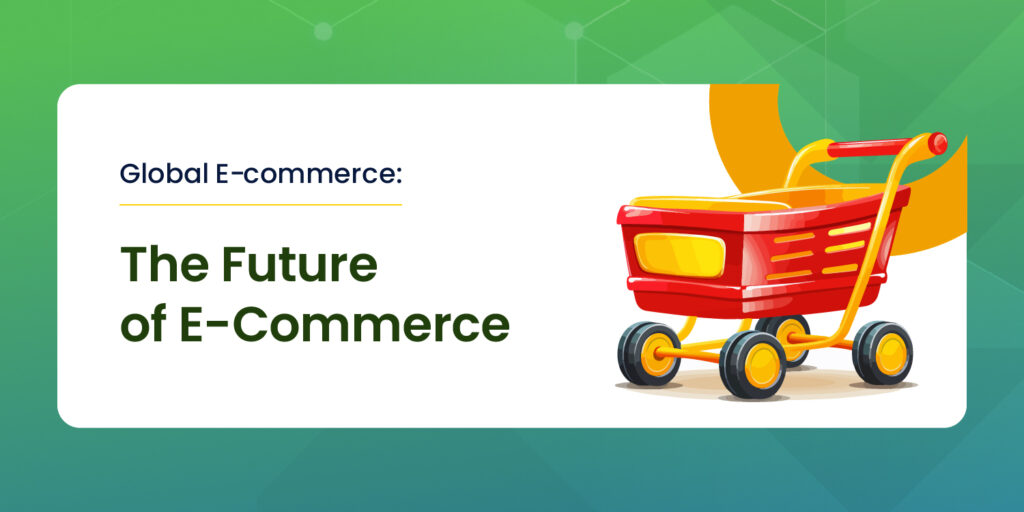The internet has opened up a world of opportunities for businesses to sell their products globally. With over 4.5 billion internet users worldwide, the potential customer base is massive. However, expanding into international e-commerce comes with its own set of challenges that need to be addressed.
Consumer shopping behavior has changed since the pandemic with a shift towards online shopping on various marketplaces & website and contactless payments.
In this comprehensive guide, we will walk you through everything you need to know about selling products cross-border on global marketplaces. We will cover choosing the right e-commerce platform, understanding compliance and regulations, calculating taxes and duties, managing logistics and deliveries, marketing your products abroad, and more.
Whether you are just starting out or looking to improve your existing international operations, this guide will provide you with a solid framework for selling products worldwide. By the end, you’ll be well-equipped to tap into the lucrative international e-commerce market. So let’s get started!
The first step to selling online internationally is finding the right e-commerce platform for your business. There are many options to choose from, each with its own pros and cons. Here are the main factors to evaluate when making your decision:
Scalability & Reliability
As your international sales grow, your website needs to be able to handle the traffic and order volume seamlessly. Make sure the platform you choose offers unlimited bandwidth and scalability. Also, check for uptime guarantees, page load speeds, and integrations with CDNs for faster performance.
Multi-language & Multi-currency Support
The platform should allow you to easily create country/region-specific store views in local languages and currencies. This improves conversion rates by 20-80% in non-English speaking markets. Auto-detect geo-IP location for currency/language selection is also handy.
Global Payment Gateways
Having access to an array of payment options like local & international credit cards, PayPal, popular wallets, etc. increases checkout conversions. Make sure the platform provides tie-ups with payment gateways that offer 200+ options.
Functionality for Global Markets
You need built-in features for international commerce like automated tax calculation, landed cost calculator, shipping integrations, etc. This eliminates guesswork and minimizes order processing time.
Some popular platforms that tick all the boxes are:
– Shopify – Best for fast set-up with easy scalability. Offers Shopify Payments integration.
– WooCommerce – Very customizable with WordPress. Has access to 1000+ plugins.
– Magento – More advanced features. Ideal for large catalogs & transaction volumes.
In the end, focus on a platform that’s easy to manage while having room to accommodate future international growth.
Selling globally brings your business under the purview of international regulations that vary widely across countries. Retailers must educate themselves to ensure compliance and avoid penalties. Here are some key areas to cover:
Tax Laws
There might be special e-commerce or distance selling taxes imposed in countries your business ships to along with regular VAT or GST. Tax calculation, collection & remittance protocols also differ. Liaising with an accountant helps stay up-to-date.
Privacy Policies & Data Protection
Regulations like the European GDPR dictate how you can collect, process, and store customer data which has implications for your website, payment systems, etc. Localize your policies as per territory-specific personal data protection laws.
Product Labelling & Descriptions
Importing country rules determine the information you must convey on product packaging, tags, or accompanying material. These span ingredients, materials used, textile care symbols, and more. Non-compliance invites penalties.
Restricted & Banned Goods
Certain categories of merchandise are prohibited or controlled across borders due to safety issues, intellectual property rights, or trade agreements. Common examples include narcotics, wildlife products, counterfeit goods, etc. Screen item eligibility beforehand.
As seen above, global commerce regulations extend to many parts of e-commerce operations. Working with localization service providers right from the platform development stages goes a long way in smoothly navigating compliance across markets.
Accurately pre-calculating taxes & import duties helps build trust with international customers during checkout by eliminating surprise charges later. Here’s what goes into it:
Import Duties
These are country-specific taxes levied on certain imported goods. Rates depend upon product category, materials, manufacturing origin, etc. Tools like DutyCalculator help estimate import duty percentages.
Taxes – VAT/GST
Value Added Tax or Goods and Services Tax gets added during checkout if your annual international sales exceed the taxable threshold in specific countries. Rates vary by product type.
Landed Costs
Alongside above, you need to account for costs incurred in international shipping when displaying the final order total to customers. This includes freight, insurance & customs clearance charges. Use a Landed Cost Calculator for this.
Also, maintain correct HS classification (global product coding system) and produce codes specific to the export-import country pair in your e-commerce system. This smoothens identifying applicable duties & taxes.
In Europe, regulations like VAT MOSS allow centralized VAT registration and payment instead of applying individually across EU markets. Utilizing such frameworks helps manage taxation efficiently.
Figuring out international shipping and fulfillment logistics is vital for providing satisfactory customer delivery experiences. Here are the steps involved:
Choosing Shipping Carriers
When reaching beyond domestic turf, you need carriers with global delivery reach. Analyze rates, delivery times, tracking facility, insurance, return logistics support, etc. while shortlisting options like DHL, FedEx, UPS, and USPS.
Warehousing & Inventory Management
If stocking at the origin warehouse, integrate inventory data feeds across sales regions for visibility into demand. Shoppers expect faster delivery and having stock local warehouses helps. It is best to work with 3P warehouses and fulfillment partners.
Landed Cost Calculator
Use carriers’ landed cost calculators to not just estimate shipping rates but also predict import taxes & duties payable in destination countries, insurance, etc. This helps provide upfront transparency on total costs.
Packaging & Commercial Invoicing
Products must be packed as per hazardous material shipping regulations. Attach commercial invoices with the nature of goods, value declarations, origin details, etc. Missing documents increase customs clearance delays.
Insurance & Claims Processing
Insuring international shipments safeguards from financial hits if goods get damaged. However, claim processing with carriers across territories is tedious. Shipping solutions like Shiplify ease such administration via tech-enabled consolidation.
Returns & Refunds
Despite best efforts, international orders see higher returns/refunds. Streamline RMA approval, pickup, and delivery tracking processes with customers. localized reverse logistics is key for upholding service standards.
Thus optimizing global shipping, freight, and fulfillment processes requires coordination across sourcing, stocking, document generation, customs, and more for end-to-end agility at scale while keeping overheads like duty, tax, and fines in check even as sales accelerate across geographies.
Expanding internationally opens doors for business growth. But simply launching your existing domestic store globally won’t reap rewards. You need uniquely customized strategies per region to succeed overseas.
Understand the Market
Start by studying target export countries’ demographics to identify rising consumer classes, and understand nuances in buyer behavior based on values, lifestyles, and preferences that shape purchasing decisions locally.
Localized Website
Creating localized store views is step #1. Adapt site UI, product descriptions, policies, support pages, etc. basis cultural nuances. Allow navigating natively in local languages or currencies.
SEO Optimization
Use keywords buyers in export countries use to find products they need. Creating locally relevant page titles, meta descriptions, and blog content fuels your search visibility.
Online Marketing
Run paid ads on popular search engines and social media channels per region. Identify and engage influential local micro-influencers as brand advocates. Participate in cross-border selling events on marketplaces users love internationally.
Payment Methods
Checkout abandonment is a huge friction globally. Plug the biggest payment method gaps in target countries via PayPal, and Apple Pay integration and partnering with prominent local wallets or installment platforms.
Stand out from competitors by fine-tuning every aspect of your e-commerce business for overseas appeal and accessibility. Localization is key for international e-commerce success.
Selling globally is rewarding but brings its own set of management challenges with order processing complexities, foreign language customer support, etc. Here are some proven ways to simplify operations:
Overseas Business Entity
Registering a separate business entity in export regions is important for smoothly paying local taxes, opening bank accounts, securing licenses, etc. rather than importing troubles of the origin country entity.
HR & Staffing
Hire locally overseas. Customer service, logistics staff, etc. with territory knowledge and language proficiency skills are best for fielding region-specific queries. Helps build connections.
Partnerships
Tie-up with local service providers specializing in customs clearance, last-mile delivery, warehousing, return pickup, etc. to ease process consolidation across markets and focus on core business.
Account Reconciliation
Maintain operational consistency across geography hubs through integrated accounting and inventory synchronization. Automate manually intensive tasks for improved transparency and control.
With business functions distributed globally, data flows getting frequent, and risks of breaches grow. Invest in security infrastructure with strong authorization protocols.
Adhering to regulations, executing problems fast amidst language barriers, and coordinating globally dispersed processes can get overwhelming without adequate preparation. Working with managed service providers from the start helps retailers entering unfamiliar turf focus on strategic goals while efficient back-end operations steer international expansion.
Summing Up Key Takeaways
International e-commerce unlocks immense business potential but needs upfront planning considering the operational intricacies it demands. Here are the key highlights:
Choose e-commerce platforms offering built-in global commerce functionalities like multi-language interfaces, currency conversions, and duties calculator.
We hope this guide has eliminated ambiguity around critical aspects like global shipping calculations, tax protocols, inventory stocking techniques, foreign market expansion strategies, and more for e-tailers embarking on international selling.

What We Do
Company
Resources
Careline:+1 (917) 5957762
© 2025 Assiduus Global INC. All Rights Reserved.



